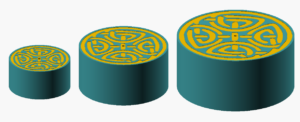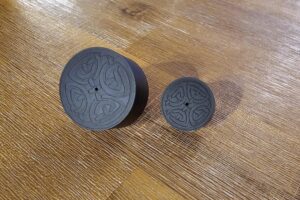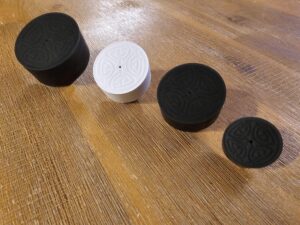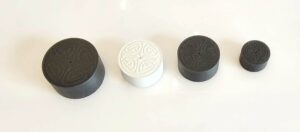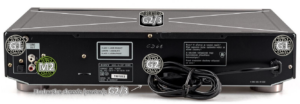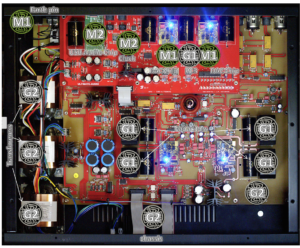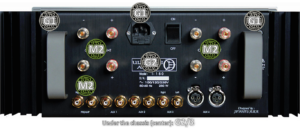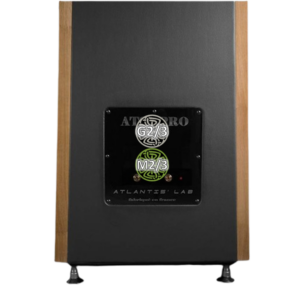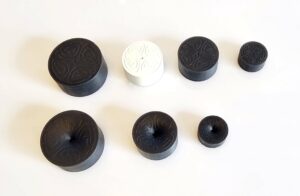GEYSÍR is a diffuser resonator, to be placed on vibrant surfaces (chassis, boards, walls).
Concept
Geysers are the expression of the release of underground over-pressure into the air, into something far less destructive than earthquakes.
Geysírs are designed with this in mind. They absorb ground/mechanical vibrations from their back thanks to some dampen base; and releases it into an airflow through a well dimensioned hole. This release is to be understood as a unaudible whistle. Which will not pollute back your system (see Daedale feet for more explanations).
To summarize, GEYSÍR is a diffuser resonator, which transforms these microphonic waves in acoustic inaudible ones… thus providing easy clarity.
Design
Please note that our labyrinth grooves on the plate-face are also there for sonic purpose. Smooth surfaces can be appreciated as neat, but are less effective in guiding air/vibrations. They lack some grip, and there is a small lazy air layer right next to flat surfaces. This reduce the system effectiveness, here to a cone opening. But this is true as well for bass-reflex speakers flow-ports of some hi-fi manufacturers, who use some grainy or hex-textured surfaces for more grasping… hence flow. A smooth 10cm diameter flow-port is considered to be like a 9cm effective diameter. Some highend loudspeakers external surfaces also show this kind of flow-helping feature. Even aircraft manufacturers work on the laminar effect of their wings on a similar manner. Or to be even simpler… imagine a golf-ball without these tiny grooves. It would be less directive, would only reach shorter distances because of a less floating ability… Ok. You got it !
Usage
Simply place Geysir Maskhål pieces on the place to protect with some blue-tac (patafix…) square and that’s it. You can try other locations. We will provide exhaustive advices soon. Please note that blue-tac blocks are provided with each Maskhål.
Known working places:
- Vibrating pieces : chassis, walls, circuitry…
- See variations section below
- more options will come with customers feedbacks – and will be inserted here
Variations
Geysírs are proposed in 3 variations. These can be mixed together. Along with Maskhåls. See dedicated sections below.
A white version is dedicated for subtle ceiling positionning.
You optionnaly can place your Geysír on a Draupnir Cable Ring for additional convenience & stability.
Geysír I, small one
Easy to place, immediate effect
- Diameter : 22mm
- Height: 11mm
Place on :
- Electronics chassis corners (back and below), where vibrations bounce and can add
- Circuitry board on small empty areas
Geysír II, standard one
More damping. requires a little more room to place
- Diameter : 32mm
- Height: 16mm
Place on :
- On the ceiling, centered between speakers, like 1.5-2m in ahead in direction to the auditor (recommended : white version)
- Electronics chassis empty-center (max vibration zone)
- on your speaker plate, between bindposts – centered
- Circuitry board on empty areas
Geysír III , the big one
Same comment as II, with richer damping & features still
- Diameter : 42mm
- Height: 20mm
Place on :
- Under your electronics chassis, at the center where vibration is at its maxium
- Circuitry board on extra large empty areas
- On top of transformers
- Under your electronics cover (hidden)
Setup pictures below are provided as a plain illustration of the textual guidelines provided above. This does not mean you need all resonators for proper performance. You can put less. You can put more. You can even put none. It’s all about experimentation & a fun path to improve sonic abilities of your existing devices. Remembers resonators are movable thankt to their bluetac/patafix patch. It’s all yours !
Maskhål or Geysír?
These can be seen as similar in their shape and in the fact that they are to counter vibrations. They can also be placed together depending on required usage.
But as a matter of clarification, consider that :
- Maskhål absorbs air-borne vibrations to protect what is behind it
- Geysír asborbs ground/mechanical vibrations and spits it in a translated/inoffensive frequency to protect what is all around
In this way, their function is opposite. But like in many things, this is not so black or white. We can consider that thanks to their relative construction similarity, Geysír act like a 30% Maskhål, and vice versa. So no worries in mixing them.
In traditional setup, we advise far more Maskhåls than Geysírs. This is easy to explain, as air-vibrations are everywhere to counter, while mechanical vibrations can be effectively refrained by placing only a couple of Geysírs on properly chosen places.
More info on Maskhål
Etymology
Geysír is the name of the oldest known geyser. It is naturally in Iceland. His spit record is a shot of 160 meters high. Geysers are the expression of the release of underground over-pressure into the air, into something far less destructive than earthquakes.
Storage precaution
Because of their Nordic origin, Maskhåls and Geysírs need to be maintained at -20°c between listening sessions. Okay… stupid joke. This is a passive system. Simply place and enjoy !


